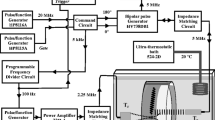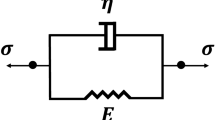Abstract
We developed a novel magnetic resonance elastography (MRE) analysis method based on Fourier transform to assess the responsive characteristics for different tissue stiffness and degree of transmission of the vibration wave emanating from a passive driver during MRE. A phantom tissue study was conducted with an MRE sequence and vibration wave system using a clinical MR scanner. The phantom tissue consisted of two layers of agar: 0.75 wt% and 1.0 wt%. Phase-unwrapped images derived from acquired MRE phase images were used to generate a phase profile curve, with a line plotted for the phase-unwrapped images. Fourier transform was performed, and the peak value of the power spectrum was derived. The damping rate/ratio was calculated using the Hilbert transform of the phase profile. We found that the mean shear stiffness value of 1.0 wt% agar was higher than that of 0.75 wt% agar. The responsive frequency of the 0.75 wt% agar layer showed a wider range and the damping rate of the signal showed a higher value than the respective values of the 1.0 wt% agar layer. In conclusion, Fourier transform analysis of MRE enabled us to obtain more detailed information of the tissue characteristics and vibration-wave conditions.







Similar content being viewed by others
References
Muthupillai R, Lomas DJ, Rossman PJ, Greenleaf JF, Manduca A, Ehman RL. Magnetic resonance elastography by direct visualization of propagating acoustic strain waves. Science. 1995;269(5232):1854–7.
Rouviere O, Yin M, Dresner MA, Rossman PJ, Burgart LJ, Fidler JL, et al. MR elastography of the liver: preliminary results. Radiology. 2006;240(2):440–8.
McKnight AL, Kugel JL, Rossman PJ, Manduca A, Hartmann LC, Ehman RL. MR elastography of breast cancer: preliminary results. AJR Am J Roentgenol. 2002;178(6):1411–7.
Kruse SA, Rose GH, Glaser KJ, Manduca A, Felmlee JP, Jack CR Jr, et al. Magnetic resonance elastography of the brain. Neuroimage. 2008;39(1):231–7.
Papazoglou S, Rump J, Braun J, Sack I. Shear wave group velocity inversion in MR elastography of human skeletal muscle. Magn Reson Med. 2006;56(3):489–97.
Yin M, Talwalkar JA, Glaser KJ, Manduca A, Grimm RC, Rossman PJ, et al. Assessment of hepatic fibrosis with magnetic resonance elastography. Clin Gastroenterol Hepatol. 2007;5(10):1207–13.
Schwimmer JB, Behling C, Angeles JE, Paiz M, Durelle J, Africa J, et al. Magnetic resonance elastography measured shear stiffness as a biomarker of fibrosis in pediatric nonalcoholic fatty liver disease. Hepatology. 2017;66(5):1474–85.
Rump J, Klatt D, Braun J, Warmuth C, Sack I. Fractional encoding of harmonic motions in MR elastography. Magn Reson Med. 2007;57(2):388–95.
Suga M, Matsuda T, Minato K, Oshiro O, Chihara K, Okamoto J, et al. Measurement of in vivo local shear modulus using MR elastography multiple-phase patchwork offsets. IEEE Trans Biomed Eng. 2003;50(7):908–15.
Braun J, Guo J, Lutzkendorf R, Stadler J, Papazoglou S, Hirsch S, et al. High-resolution mechanical imaging of the human brain by three-dimensional multifrequency magnetic resonance elastography at 7T. Neuroimage. 2014;90:308–14.
Venkatesh SK, Yin M, Ehman RL. Magnetic resonance elastography of liver: technique, analysis, and clinical applications. J Magn Reson Imaging. 2013;37(3):544–55.
Zhang X. A surface wave elastography technique for measuring tissue viscoelastic properties. Med Eng Phys. 2017;42:111–5.
Feldman M. Non-linear system vibration analysis using Hilbert transform–II. Forced vibration analysis method ‘Forcevib’. Mech Syst Signal Process. 1994;3:309–18.
Benitez D, Gaydecki PA, Zaidi A, Fitzpatrick AP. The use of the Hilbert transform in ECG signal analysis. Comput Biol Med. 2001;31(5):399–406.
Manduca A, Oliphant TE, Dresner MA, Mahowald JL, Kruse SA, Amromin E, et al. Magnetic resonance elastography: non-invasive mapping of tissue elasticity. Med Image Anal. 2001;5(4):237–54.
Silva AM, Grimm RC, Glaser KJ, Fu Y, Wu T, Ehman RL, et al. Magnetic resonance elastography: evaluation of new inversion algorithm and quantitative analysis method. Abdom Imaging. 2015;40(4):810–7.
Yoshimitsu K, Shinagawa Y, Mitsufuji T, Mutoh E, Urakawa H, Sakamoto K, et al. Preliminary comparison of multi-scale and multi-model direct inversion algorithms for 3T MR elastography. Magn Reson Med Sci. 2017;16(1):73–7.
Goldstein RM, Zebker HA, Werner CL. Satellite radar interferometry: two-dimensional phase unwrapping. Radio Sci. 1988;23(4):713–20.
Funding
The authors declare no financial or commercial conflict of interest.
Author information
Authors and Affiliations
Corresponding author
Ethics declarations
Conflict of interest
The authors declare that they have no conflict of interest.
Ethical approval
This article does not contain any studies with human participants or animals performed by any of the authors.
Additional information
Publisher's Note
Springer Nature remains neutral with regard to jurisdictional claims in published maps and institutional affiliations.
About this article
Cite this article
Kosaka, I., Kanazawa, Y., Baba, K. et al. Quantitative analysis of vibration waves based on Fourier transform in magnetic resonance elastography. Radiol Phys Technol 13, 268–275 (2020). https://doi.org/10.1007/s12194-020-00579-y
Received:
Revised:
Accepted:
Published:
Issue Date:
DOI: https://doi.org/10.1007/s12194-020-00579-y




